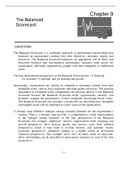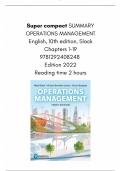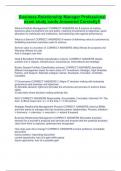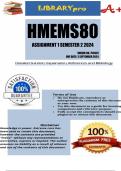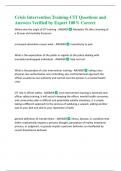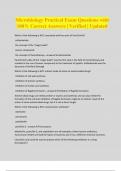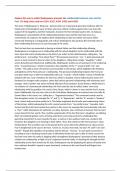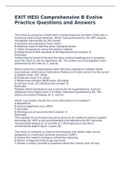Chapter 9
The Balanced
Scorecard
QUESTIONS
The Balanced Scorecard is a systematic approach to performance measurement that
translates an organization’s strategy into clear objectives, measures, targets, and
initiatives. The Balanced Scorecard integrates an appropriate mix of short- and
long-term financial and non-financial performance measures used across the
organization, and helps organizations grapple with their intangible or intellectual
assets.
The four measurement perspectives in the Balanced Scorecard are: (1) financial,
(2) customer, (3) internal, and (4) learning and growth.
Increasingly, organizations are relying on competitive advantage created from their
intangible assets, such as loyal customers and high-quality processes. The growing
importance of intangible assets complements the growing interest in the Balanced
Scorecard because the Balanced Scorecard helps organizations measure, and
therefore, manage the performance of their intangible, knowledge-based, assets.
The Balanced Scorecard also provides a framework for describing how intangible
and tangible assets will be combined to create value for the organization.
A strategy map identifies linkages among essential elements for the organization’s
strategy. That is, a strategy map provides a comprehensive visual representation
of the linkages among measures in the four perspectives of the Balanced
Scorecard. For example, employees’ process improvement skills (learning and
growth perspective) drive process quality and process cycle time (internal
perspective), which in turn leads to on-time delivery and customer loyalty
(customer perspective), ultimately leading to a higher return on investment
(financial perspective). This example shows how an entire chain of cause-and-
effect relationships can be described to interconnect measures in each of the four
perspectives.
– 273 –
,Atkinson, Solution Manual t/a Management Accounting, 4E
A strategy map includes objectives, measures, targets and initiatives. Objectives
concisely express actions and the desired results. An organization’s Balanced
Scorecard typically contains a more extensive description of each objective. An
example of an objective for the financial perspective might be to increase
revenues through expanded sales to existing customers. Measures describe how
success in achieving an objective will be determined. A measure should be
specific in order to provide clear focus. An example of a measure for the
objective above might be to measure the percent increase in sales to existing
customers each month. Targets establish the level of performance or rate of
improvement required for a given measure. For example, a target could be a
two percent increase in sales each month to existing customers. Often
organizations identify initiatives for achieving the targets of their measures. An
initiative is a short-term program and action plan that is designed to help the
organization achieve specific targets. An example of an initiative might be to
require sales representatives to participate in sales training each year.
A vision statement is a concise statement that defines the mid-to-long-term (3- to
10-year) goals of the organization. It should be external and market-oriented
and should express how the organization wants to be perceived by the world. A
vision statement could, for example, state the following: ―We will become the
respected leader in financial services with a focus on seamless customer
relationship and satisfaction, producing financial returns in the top quartile of
the industry.‖ A mission statement is a concise, internally focused statement of
how an organization expects to compete and deliver value to customers. Ben &
Jerry’s mission statement regarding its products stated the following: ―To
make, distribute, and sell the finest-quality all natural ice cream in a wide
variety of innovative flavors made from Vermont dairy products.‖
This chapter uses the framework articulated by Michael Porter. Porter states that
strategy is about selecting the set of activities in which an organization will
excel to create a sustainable difference in the marketplace. The sustainable
difference may, for example, arise from delivering greater value to customers
than competitors or providing comparable value at lower cost than competitors.
The two basic approaches to improving a company’s financial performance are:
(1) revenue growth and (2) productivity.
Companies can generate additional revenues by selling new products to existing
customers, and by selling to new customers or in new markets.
– 274 –
, Chapter 9: The Balanced Scorecard
Productivity improvements can be achieved in two ways: (1) reducing costs by
lowering direct and indirect expenses, and (2) utilizing financial and physical
assets more efficiently to reduce the working and fixed capital needed to support a
given level of business.
A strategy identifies a way in which an organization can create a sustainable difference
over the competition. Virtually all organizations try to improve in terms of
customer satisfaction, customer retention, customer profitability, and market share,
but improvements in these measures do not necessarily constitute a strategy. For
example, a strategy often identifies specific customer segments that a company is
targeting for growth and profitability, in order to achieve the organization’s
financial objectives.
A value proposition defines the company’s strategy by specifying the unique mix of
product, price, service, relationship, and image that an organization offers its
targeted group of customers in order to meet customers’ needs better or differently
from its competitors. The ―best buy‖ or lowest total cost value proposition is used
by companies such as Target (http://www.target.com), Southwest Airlines, Dell
Computers, and Wal-Mart. The objectives of this value proposition emphasize
attractive prices, excellent and consistent quality for the product attributes offered,
good selection, short lead times, and ease of purchase. McDonald’s, for example, is
very inexpensive, serves food of consistent taste and quality, and serves customers
very quickly.
The product innovation and leadership value proposition is followed by companies
such as Tektronix (which designs and produces measurement and monitoring
instrumentation, http://www.tek.com), Sony, Mercedes, and Intel. This value
proposition emphasizes particular features and functionalities of the products that
leading-edge customers place value in and are willing to pay more to receive.
Specific measures include speed, accuracy, size, and power that exceed the
performance of competing products. It is important to be first- to-market when
using the product innovation and leadership value proposition.
The complete customer solutions value proposition is followed by companies such as
Home Depot (http://www.homedepot.com), whose salespersons can teach
customers how to use the products they buy at the store, Goldman Sachs, and IBM.
This value proposition focuses on making customers feel that the company
understands them and is capable of providing them with customized products
and/or services tailored to their needs. Certain objectives that are stressed include
completeness of the solution, exceptional service both before and after the sale, and
the quality of the relationship.
– 275 –
The Balanced
Scorecard
QUESTIONS
The Balanced Scorecard is a systematic approach to performance measurement that
translates an organization’s strategy into clear objectives, measures, targets, and
initiatives. The Balanced Scorecard integrates an appropriate mix of short- and
long-term financial and non-financial performance measures used across the
organization, and helps organizations grapple with their intangible or intellectual
assets.
The four measurement perspectives in the Balanced Scorecard are: (1) financial,
(2) customer, (3) internal, and (4) learning and growth.
Increasingly, organizations are relying on competitive advantage created from their
intangible assets, such as loyal customers and high-quality processes. The growing
importance of intangible assets complements the growing interest in the Balanced
Scorecard because the Balanced Scorecard helps organizations measure, and
therefore, manage the performance of their intangible, knowledge-based, assets.
The Balanced Scorecard also provides a framework for describing how intangible
and tangible assets will be combined to create value for the organization.
A strategy map identifies linkages among essential elements for the organization’s
strategy. That is, a strategy map provides a comprehensive visual representation
of the linkages among measures in the four perspectives of the Balanced
Scorecard. For example, employees’ process improvement skills (learning and
growth perspective) drive process quality and process cycle time (internal
perspective), which in turn leads to on-time delivery and customer loyalty
(customer perspective), ultimately leading to a higher return on investment
(financial perspective). This example shows how an entire chain of cause-and-
effect relationships can be described to interconnect measures in each of the four
perspectives.
– 273 –
,Atkinson, Solution Manual t/a Management Accounting, 4E
A strategy map includes objectives, measures, targets and initiatives. Objectives
concisely express actions and the desired results. An organization’s Balanced
Scorecard typically contains a more extensive description of each objective. An
example of an objective for the financial perspective might be to increase
revenues through expanded sales to existing customers. Measures describe how
success in achieving an objective will be determined. A measure should be
specific in order to provide clear focus. An example of a measure for the
objective above might be to measure the percent increase in sales to existing
customers each month. Targets establish the level of performance or rate of
improvement required for a given measure. For example, a target could be a
two percent increase in sales each month to existing customers. Often
organizations identify initiatives for achieving the targets of their measures. An
initiative is a short-term program and action plan that is designed to help the
organization achieve specific targets. An example of an initiative might be to
require sales representatives to participate in sales training each year.
A vision statement is a concise statement that defines the mid-to-long-term (3- to
10-year) goals of the organization. It should be external and market-oriented
and should express how the organization wants to be perceived by the world. A
vision statement could, for example, state the following: ―We will become the
respected leader in financial services with a focus on seamless customer
relationship and satisfaction, producing financial returns in the top quartile of
the industry.‖ A mission statement is a concise, internally focused statement of
how an organization expects to compete and deliver value to customers. Ben &
Jerry’s mission statement regarding its products stated the following: ―To
make, distribute, and sell the finest-quality all natural ice cream in a wide
variety of innovative flavors made from Vermont dairy products.‖
This chapter uses the framework articulated by Michael Porter. Porter states that
strategy is about selecting the set of activities in which an organization will
excel to create a sustainable difference in the marketplace. The sustainable
difference may, for example, arise from delivering greater value to customers
than competitors or providing comparable value at lower cost than competitors.
The two basic approaches to improving a company’s financial performance are:
(1) revenue growth and (2) productivity.
Companies can generate additional revenues by selling new products to existing
customers, and by selling to new customers or in new markets.
– 274 –
, Chapter 9: The Balanced Scorecard
Productivity improvements can be achieved in two ways: (1) reducing costs by
lowering direct and indirect expenses, and (2) utilizing financial and physical
assets more efficiently to reduce the working and fixed capital needed to support a
given level of business.
A strategy identifies a way in which an organization can create a sustainable difference
over the competition. Virtually all organizations try to improve in terms of
customer satisfaction, customer retention, customer profitability, and market share,
but improvements in these measures do not necessarily constitute a strategy. For
example, a strategy often identifies specific customer segments that a company is
targeting for growth and profitability, in order to achieve the organization’s
financial objectives.
A value proposition defines the company’s strategy by specifying the unique mix of
product, price, service, relationship, and image that an organization offers its
targeted group of customers in order to meet customers’ needs better or differently
from its competitors. The ―best buy‖ or lowest total cost value proposition is used
by companies such as Target (http://www.target.com), Southwest Airlines, Dell
Computers, and Wal-Mart. The objectives of this value proposition emphasize
attractive prices, excellent and consistent quality for the product attributes offered,
good selection, short lead times, and ease of purchase. McDonald’s, for example, is
very inexpensive, serves food of consistent taste and quality, and serves customers
very quickly.
The product innovation and leadership value proposition is followed by companies
such as Tektronix (which designs and produces measurement and monitoring
instrumentation, http://www.tek.com), Sony, Mercedes, and Intel. This value
proposition emphasizes particular features and functionalities of the products that
leading-edge customers place value in and are willing to pay more to receive.
Specific measures include speed, accuracy, size, and power that exceed the
performance of competing products. It is important to be first- to-market when
using the product innovation and leadership value proposition.
The complete customer solutions value proposition is followed by companies such as
Home Depot (http://www.homedepot.com), whose salespersons can teach
customers how to use the products they buy at the store, Goldman Sachs, and IBM.
This value proposition focuses on making customers feel that the company
understands them and is capable of providing them with customized products
and/or services tailored to their needs. Certain objectives that are stressed include
completeness of the solution, exceptional service both before and after the sale, and
the quality of the relationship.
– 275 –

